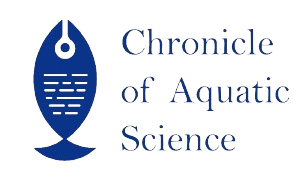| File | Action |
|---|---|
| Shah et al., (2023) | Download |
- 919088951040 call us
- chronicleofaquaticscience@gmail.com Mail us
CoAS_V1IS1_02
Mini-review
Structure and Applications of Antifreeze Proteins from Fishes: A Mini Review
Azra Shah , Ishtiyaq Ahmad , Irfan Ahmad , Ashfauq Farooq Aga , Adnan Amin , Saba Khursheed , Mohd Ashraf Rather*
Abstract
Antifreeze proteins (AFPs) are a unique class of proteins that enables certain fish species to survive in extremely cold environments. These proteins can bind to ice crystals and inhibit their growth, thereby preventing freezing. Fish produce a range of AFPs with different structures and mechanisms of action, making them a fascinating research subject. The study of AFPs in fish has provided valuable insights into the molecular mechanisms of protein-ice interactions, which have potential applications in the fields of biotechnology and cryopreservation. This study aimed to review the current understanding of AFPs in fish, including their structure, function, and evolutionary history. This paper also discusses the potential applications of AFPs in biotechnology, such as in the development of antifreeze materials and cryopreservation of biological samples.
Keywords
Antifreeze proteins, applications, biotechnological role, fish species
Corresponding Author
Mohd. Ashraf Rather
References
- 1. Antson, A. A., Smith, D. J., Roper, D. I., Lewis, S., Caves, L. S., Verma, C. S., ... & Hubbard, R. E. (2001). Understanding the mechanism of ice-binding by type III antifreeze proteins. Journal of Molecular Biology, 305(4), 875-889.
- 2. Baardsnes, J., & Davies, P. L. (2001). Sialic acid synthase: the origin of fish type III antifreeze protein. Trends in Biochemical Sciences, 26(8), 468-469.
- 3. Baardsnes, J., & Davies, P. L. (2002). Contribution of hydrophobic residues to ice binding by fish type III antifreeze protein. Biochimica et Biophysica Acta (BBA)-Proteins and Proteomics, 1601(1), 49-54.
- 4. Bagis H, Akkoç T, Taş A, Aktoprakligil D (2008) Cryogenic effect of antifreeze protein on transgenic mouse ovaries and the production of live offspring by orthotopic transplantation of cryopreserved mouse ovaries. Mol Reprod Dev 75:608–613.
- 5. Bhat, I. A., Rather, M. A., Dar, J. Y., & Sharma, R. (2016). Molecular cloning, computational analysis and expression pattern of forkhead box l2 (Foxl2) gene in catfish. Computational Biology and Chemistry, 64, 9-18.
- 6. Budke, C., Dreyer, A., Jaeger, J., Gimpel, K., Berkemeier, T., Bonin, A. S., ... & Koop, T. (2014). Quantitative efficacy classification of ice recrystallization inhibition agents. Crystal Growth & Design, 14(9), 4285-4294.
- 7. Chao, H., Davies, P. L., & Carpenter, J. F. (1996). Effects of antifreeze proteins on red blood cell survival during cryopreservation. The Journal of Experimental Biology, 199(9), 2071-2076.
- 8. Crevel, R. W. R., Fedyk, J. K., & Spurgeon, M. J. (2002). Antifreeze proteins: characteristics, occurrence and human exposure. Food and Chemical Toxicology, 40(7), 899-903. Davies, P. L., & Hew, C. L. (1990). Biochemistry of fish antifreeze proteins. The FASEB Journal, 4(8), 2460-2468.
- 9. Deng, C., Cheng, C. H. C., Ye, H., He, X., & Chen, L. (2010). Evolution of an antifreeze protein by neofunctionalization under escape from adaptive conflict. Proceedings of the National Academy of Sciences, 107(50), 21593- 21598.
- 10. Deng, G., Andrews, D. W., & Laursen, R. A. (1997). Amino acid sequence of a new type of antifreeze protein, from the longhorn sculpin Myoxocephalus octodecimspinosis. FEBS letters, 402(1), 17-20.
- 11. DeVries, A. L., Komatsu, S. K., & Feeney, R. E. (1970). Chemical and physical properties of freezing point-depressing glycoproteins from Antarctic fishes. Journal of Biological Chemistry, 245(11), 2901-2908.
- 12. DeVries, A. L. (1986). Antifreeze glycopeptides 127, pp. 293-303). Academic Press. Ding, X., Zhang, H., Liu, W., Wang, L., Qian, H., & Qi, X. (2014). Extraction of carrot (Daucus carota) antifreeze proteins and evaluation of their effects on frozen white salted noodles. Food and Bioprocess Technology, 7, 842-852.
- 13. Duman, J. G. (1994). Purification and characterization of a thermal hysteresis protein from a plant, the bittersweet nightshade Solanum dulcamara. Biochimica et Biophysica Acta (BBA)-Protein Structure and Molecular Enzymology, 1206(1), 129- 135.
- 14. Eskandari, A., Leow, T. C., Rahman, M. B. A., & Oslan, S. N. (2020). Antifreeze proteins and their practical utilization in industry, medicine, and agriculture. Biomolecules, 10(12), 1649.
- 15. Ewart, K. V., Lin, Q., & Hew, C. L. (1999). Structure, function and evolution of antifreeze proteins. Cellular and Molecular Life Sciences CMLS, 55, 271- 283.
- Published online
- 20th June, 2023
How to Cite the Article
Shah A, Ahmad I, Ahmad A, Aga AF, Amin A, Khursheed S and Rather MA (2023) Structure and Applications of antifreeze proteins from fishes: A Mini Review. Chronicle of Aquatic Science 1(1): 3-11
Copyright
This is an open-access article distributed under the terms of the Creative Commons Attribution License (CC BY). The use, distribution or reproduction in other forums is permitted, provided the original author(s) and the copyright owner(s) are credited and that the original publication in this journal is cited, in accordance with accepted academic practice. No use, distribution or reproduction is permitted which does not comply with these terms.

Shah et al., 2023


